Lesson 25.4: Sexually Transmitted Diseases
Lesson 25.4: Sexually Transmitted Diseases
Lesson Objectives
Explain how STDs are transmitted and how they can be prevented.
Identify and describe three common bacterial STDs.
Identify and describe three common viral STDs.
Introduction
A sexually transmitted disease (STD) is an illness caused by a pathogen that is trans- mitted from one person to another mainly through sexual contact. Worldwide, as many as one million people a day become infected with STDs. The majority of these infections occur in people under the age of 25.
Sexually Transmitted Diseases
Common STDs include chlamydia, gonorrhea, syphilis, human immunodeficiency virus (HIV) infection, genital herpes, hepatitis B, and genital warts. To be considered an STD, a disease must have only a small chance of spreading naturally in ways other than sexual contact. Many diseases that can spread through sexual contact spread more commonly by other means. These diseases are not considered STDs.
Pathogens that Cause STDs
STDs may be caused by several different types of pathogens, including protozoa, insects, bacteria, and viruses.
The protozoa Trichomonas vaginalis causes an STD called trichomoniasis. This is an infection of the vagina in females and the urethra in males.
Pubic lice, like the one in Figure 25.18, are insect parasites that can be transmitted sexually. They suck the blood of their host and irritate the skin in the pubic area.
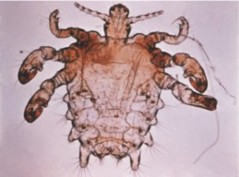
Figure 25.18: A magnified pubic louse (Phthirius pubis). (18)
Although these STDs are common, the majority of STDs are caused by bacteria or viruses. Several bacterial and viral STDs are described below. It is important to note that most bacterial STDs can be cured with antibiotics, whereas viral STDs do not have cures, although some can be prevented with vaccines.
How STDs Spread
Most of the pathogens that cause STDs enter the body through mucous membranes of the reproductive organs. All sexual behaviors that involve contact between mucous membranes put a person at risk for infection. This includes vaginal, anal, and oral sexual behaviors.
Many STDs can also be transmitted through body fluids such as blood, semen, and breast milk. For example, in the past, HIV and hepatitis B were transmitted through blood trans- fusions. This no longer occurs because donated blood is now screened for the pathogens. Use of shared injection or tattoo needles is another way in which blood and pathogens can be transferred from one person to another. A number of STDs can also be transmitted from a mother to her baby through her blood during childbirth or through her breast milk after birth.
STDs are much more common in young adults and teens than in older people. One reason is that young people are more likely to take risks and to think “It can’t happen to me.” They also may not know how STDs are spread. In addition, younger people may be more sexually active than older people.
Preventing STDs
The only completely effective way to prevent infection with STDs is to avoid sexual activity and other known risk behaviors, such as using contaminated needles. Using condoms can decrease the risk of contracting STDs during some types of sexual activity. However, using condoms is not a foolproof method. Pathogens may be present on areas of the body not covered by condoms. Condoms can also break or be used incorrectly.
Bacterial STDs
Many STDs are caused by bacteria. Some of the most common bacterial STDs are chlamydia, gonorrhea, and syphilis.
Chlamydia
Chlamydia is an STD caused by the bacterium Chlamydia trachomatis. It is the most common STD in the U.S. Each year, about four million new chlamydia infections occur in Americans. As shown in Figure 25.19, females are much more likely to develop chlamydia than males. This figure also shows how common this STD is in teens and young adults compared with older people. This is typical of most STDs.
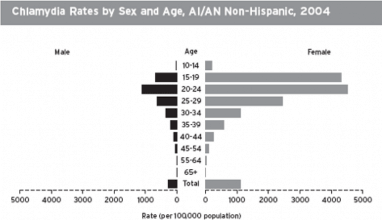
Symptoms of chlamydia may include a burning sensation during urination and a discharge from the vagina or penis. Chlamydia can be cured with antibiotics. However, in the majority of cases, there are no symptoms. As a result, many people are not aware they are infected and do not seek treatment.
It is important to detect and treat chlamydia infections even when they do not cause symp- toms. Untreated chlamydia can lead to more serious problems, especially in females. Almost half of all women with untreated chlamydia develop pelvic inflammatory disease (PID), which is an infection of the uterus, Fallopian tubes, and/or ovaries. PID can lead to scar- ring of the reproductive organs, which may cause pain and difficulty becoming pregnant. Chlamydia causes an estimated half million cases of PID in the U.S. each year.
In addition to sexual transmission, chlamydia can be passed from a woman to her baby before or during birth. Before birth, chlamydia infection of the fetus may cause the fetus to be born too soon. During birth, a baby’s eyes can become infected with the bacteria. If the eye infection is not treated, it can lead to blindness. Because chlamydia is common and often symptomless, newborns are treated routinely with eye drops to prevent chlamydia eye infections from developing.
Gonorrhea
Gonorrhea is an STD caused by the bacterium Neisseria gonorrheae. Gonorrhea is also a common STD. In the U.S., an estimated 700,000 people are infected with gonorrhea each year.
Symptoms of gonorrhea may include painful urination and discharge from the vagina or penis. Gonorrhea usually can be cured with antibiotics, although the bacteria have developed resistance to the most commonly used antibiotics. Gonorrhea infections may not cause symptoms, especially in females, so they often go untreated. Untreated gonorrhea can lead to PID in females. In males, it can lead to inflammation of the epididymis, prostate, and urethra.
Gonorrhea can be passed from an infected woman to her baby during childbirth. This may cause an eye infection. The infection must be treated promptly to prevent blindness.
Syphilis
Syphilis is an STD caused by the bacterium Treponema pallidum. In the U.S., about 70,000 new cases of syphilis occur each year. Syphilis is less common than either chlamydia or gonorrhea, but it is more serious if it is not treated. Untreated syphilis can even cause death.
Early symptoms of infection with syphilis include the development of a small sore on or near the genitals. The sore is painless and heals on its own, so it may go unnoticed. Many people do not realize they have become infected until much later, so they do not seek treatment. If diagnosed and treated early, most cases of syphilis can be cured with antibiotics. However, if syphilis goes untreated, the disease may progress through the stages shown in Table 25.6. Untreated syphilis can eventually cause serious damage to the heart, brain, and other organs.
Table 25.6: Stages of Syphilis Infection
Stage Time After Initial Infection Signs and Symptoms
Primary 2 days Small sore on genitals
Secondary 1–6 months Rash, fever, sore throat, headache
Latent 6–12 months None
Tertiary 1–10 years Chronic inflammation, dam- age to aorta and heart, nar- rowing of arteries, stroke, meningitis, muscle weakness
Viral STDs
STDs caused by viruses include genital herpes, hepatitis B, genital warts, and cancer of the cervix. Another common viral STD is HIV infection, which causes acquired immune deficiency syndrome, or AIDS. HIV and AIDS are described in the chapter titled Immune System and Disease.
Genital Herpes
Genital herpes is an STD caused by herpes simplex virus type 2 (HSV-2). In the U.S., as many as 20% of males and 25% of females may be infected with HSV-2. The virus is closely related to herpes simplex virus type 1 (HSV-1), which causes cold sores on the lips. Both viruses are transmitted by direct contact. Both also cause similar symptoms, except HSV-2 infects the genitals instead of the mouth.
Symptoms of genital herpes include painful, fluid-filled blisters on the penis, vulva, or nearby membranes (Figure 25.20). The initial infection soon clears up on its own. However, herpes virus particles travel to local nerves, where they evade the immune system and remain for the life of the infected person. Periodically, some of the virus particles travel back to the skin and cause new outbreaks of blisters. Outbreaks may be triggered by stress or other factors. A person with genital herpes is most likely to transmit the virus during an outbreak.
There is no known cure for genital herpes. Once a person becomes infected, there is no way to eradicate the virus from the body. However, antiviral drugs can prevent outbreaks or reduce their length and severity. The drugs also reduce the risk of transmitting the virus. A vaccine to prevent infections with HSV-2 may soon be available.
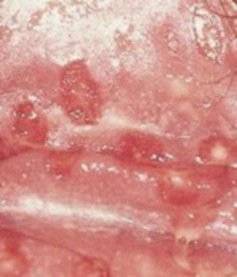
Genital herpes may cause emotional problems because it affects intimate relationships through- out a person’s life. However, it is not considered to be a serious disease from the standpoint of physical health. On the other hand, herpes is very serious for newborns if they are in- fected with the virus during childbirth. It can lead to blindness, mental retardation, and even death.
Hepatitis B
Hepatitis B is inflammation of the liver caused by infection with the hepatitis B virus. In the U.S., there are about 200,000 new cases of hepatitis B diagnosed each year. In addition, as many as 5,000 Americans die each year from hepatitis B infections.
Early symptoms of hepatitis B include vomiting and jaundice, which is yellowing of the skin and eyes. Hepatitis B often gets better on its own after a few weeks or months and causes no long-lasting effects. However, in a small percentage of people it develops into a chronic, or long-term, disease. In some people, chronic hepatitis B causes few if any symptoms, although people infected with the virus can still spread it to others. In other people, chronic hepatitis B causes continuous inflammation of the liver. This eventually damages the liver. It also increases the risk of liver cancer, which is usually fatal.
Hepatitis B cannot be cured. Antiviral drugs can help prevent liver damage in people with chronic hepatitis B, but they cannot eradicate the virus from the body. However, vaccines have been developed to prevent hepatitis B infection.
In addition to sexual transmission, hepatitis B is commonly transmitted through contami- nated needles and from mother to child during childbirth. Newborns are much more likely than older people to develop chronic hepatitis B. This is because their immune system is immature and unable to fight off the virus.
Genital Warts and Cervical Cancer
Both genital warts and cancer of the cervix are caused by the human papillomavirus (HPV). There are more than 100 types of HPV. Some types of HPV cause common warts, which are small, rough growths on the hands, knees, or feet. These HBV viruses are transmitted by casual skin-to-skin contact. Other types of HPV cause genital warts or cervical cancer. These HPV viruses are transmitted through sexual contact. Genital HPV infections are very common. In the U.S., more than six million people become infected each year.
Many types of HPV that are transmitted sexually do not cause any noticeable symptoms. However, several types cause genital warts or cervical cancer. Cervical cancer is easily detected with a Pap test, which involves examining a sample of cervical cells for cancerous changes. If detected early, cervical cancer can be cured with surgery. Since 2006, a vaccine has been available to prevent transmission of the most common types of HPV that cause genital warts and cervical cancer. The vaccine is recommended for females from aged 11 to 26 years.
Lesson Summary
STDs are diseases caused by pathogens that spread through sexual contact. Abstinence from sexual activity is the only completely effective way to prevent the spread of STDs.
Bacterial STDs include chlamydia, gonorrhea, and syphilis. These diseases can be cured with antibiotics.
Viral STDs include genital herpes, hepatitis B, genital warts, and cervical cancer. These diseases cannot be cured, but some of them can be prevented with vaccines.
Review Questions
Further Reading / Supplemental Links
Describe how STDs spread.
What is the only completely effective way to prevent infection from STDs?
Identify three common STDs that are caused by bacteria.
Name and describe an STD caused by a virus.
Why is it important to treat STDs even when they do not cause symptoms?
How does lack of symptoms contribute to the spread of STDs?
Jeyendran, Rajasingam S., Sex, Sperm, & STDs: What Every Teenage Boy Needs to Know. iUniverse, Inc., 2006.
Stanley, Deborah, Sexual Health Information for Teens. Omnigraphics, 2003.
http://www.cdc.gov/STD/stats04/trends2004.htm
http://www.wrongdiagnosis.com/c/chlamydia/prevalence.htm
http://www.wrongdiagnosis.com/h/hepatitis_b/prevalence.htm
http://www.wrongdiagnosis.com/s/syphilis/prevalence.htm
http://www.cdc.gov/nchstp/dstd/disease_info.htm
http://www.kidshealth.org/teen/sexual_health/stds/std.html
http://www.4woman.org/faq/stdsgen.htm
Vocabulary
chlamydia A STD caused by the bacterium Chlamydia trachomatis; the most common STD in the U.S. Each year, about four million new chlamydia infections occur in Americans.
genital herpes An STD caused by herpes simplex virus type 2 (HSV-2). In the U.S., as many as 20% of males and 25% of females may be infected with HSV-2.
gonorrhea An STD caused by the bacterium Neisseria gonorrheae. In the U.S., an esti- mated 700,000 people are infected with gonorrhea each year.
hepatitis B An inflammation of the liver caused by infection with the hepatitis B virus.
pelvic inflammatory disease (PID) An infection of the uterus, Fallopian tubes, and/or ovaries.
sexually transmitted disease (STD) A illness caused by a pathogen that is transmitted from one person to another mainly through sexual contact.
syphilis An STD caused by the bacterium Treponema pallidum. In the U.S., about 70,000 new cases of syphilis occur each year.
Points to Consider
From fertilization to old age, the human body is like a fantastic machine. It controls its own growth and development, protects itself from dangers in the outside world and has amazing abilities to act, think, and feel. Like other living things, human beings are marvels of nature.
What have you learned about human beings and other organisms by reading this book?
Image Sources
http://estrellamountain.edu/faculty/farabee/biobk/BioBookREPROD.html. Creative Commons.
http://www.cdc.gov/std/stats-ihs-2004/graphs/chlamydia-natl.htm. Public Domain.
http://en.wikipedia.org/wiki/Image:Blastulation.png. Public Domain.
http://en.wikipedia.org/wiki/Image:Blastocyst.png. GNU-FDL.
http://commons.wikimedia.org/wiki/File:Estradiol.Cycle.jpg. GNU-FDL.
Six-week-old baby’s first smile.. Creative Commons.
http://estrellamountain.edu/faculty/farabee/biobk/BioBookREPROD.html. Public Domain.
http://commons.wikimedia.org/wiki/Image:Order_of_changes_in_ovary.svg. GNU-FDL.
[Wikimedia.org ]. Creative Commons.
Mariana Ruiz. http://en.wikipedia.org/wiki/Image:Simplified_spermatozoon_diagram.svg. Public Domain.
Baby with fetal alcohol syndrome.. Creative Commons.
http://estrellamountain.edu/faculty/farabee/biobk/BioBookREPROD.html. Creative Commons.
CDC. Internal female reproductive organs.. Public Domain.
CK-12 Foundation. Cross-section of a human breast.. CC-BY.
The female reproductive system.. GNU-FDL.
http://commons.wikimedia.org/wiki/File:Gray1150.png. Public Domain.
http://commons.wikimedia.org/wiki/File:SOA-Herpes-genitalis-female.jpg. GNU-FDL.
Centers for Disease Control and Prevention. http://commons.wikimedia.org/wiki/File:Pthius_pubis_-_crab_louse.jpg. Public Domain.
Human sperm and egg.. Public Domain.
http://commons.wikimedia.org/wiki/File:Cell_differentiation.gif. Public Domain.
Chapter 26 Appendix: Biology I
26.1 Investigation and Experimentation Activities
The following activities are based on information provided within this FlexBook or taken directly from the Teacher Edition.
Collecting and Analyzing Data
In this activity students will select and use appropriate tools and technology to perform tests, collect data, analyze relationships, and display data.
Students build skills in interpreting data and measuring through a simple activity. Have students measure a certain volume of water into a number of cups, such as 4 - 10 cups. Then have them first look online for what the threshold amount is for detecting sugar in water (see:http://www.skidmore.edu/~hfoley/Perc2.htm#ch2demo1).
Have one cup with water only (the control), and then have students add increasing amounts of sugar to each of the remaining cups. Keep track of the amount of sugar added. Have a person record for each student the threshold when that student detects the sugar (by taste) in the solution. The results are then tabulated and a graph made showing the number of students detecting the sugar solution at each concentration.
Experimental Error and Inconsistent Results
Students will identify and communicate sources of unavoidable experimental error and de- termine possible reasons for inconsistent results, such as sources of error or uncontrolled conditions.
As an extension to the above activity, have students conduct an experiment with the same amount of sugar and water in each cup. Use an amount in which the sugar is detectable. Ask students to determine if there is the same or different amounts of sugar. Some students will determine that there are different amounts of sugar in the cups. Discuss the possible reasons for these results and how inconsistent results can influence collected data. You may choose to have one group of students set up the experiment for you (these students will not participate in the collection of data), with another group blind to the experimental conditions.
Experimental Error
An error is a boundary on the precision and accuracy of the result of a measurement. Some errors are caused by unpredictable changes in the measuring devices (such as balances, rulers, or calipers), but other errors can be caused by reading a measuring device incorrectly or by using broken or malfunctioning equipment. Such errors can have an impact on the reliability of the experiment’s results; they affect the accuracy of measurements. For example, you use a balance to obtain the mass of a 100 gram block. Three measurements that you get are:
g, 92.0 g, and 91.8 g. The measurements are precise, as they are close together, but they are not accurate.
If the cause of the error can be identified, then it can usually be eliminated or minimized. Reducing the number of possible errors by careful measurement and using a large enough sample size to reduce the effect of errors will improve the reliability of your results.
Have students discuss potential opportunities for experimental error in the above activity, and have them describe how they could have affected the experimental results. Have the class discuss controls they could have added to this test to reduce experimental error.
Scientific Models
During this activity, students should realize that appropriate tools and technology (such as computer-linked probes, spreadsheets, and graphing calculators) are used to perform tests, collect data, analyze relationships, and display data. Throughout this activity, students should also recognize both the usefulness and limitations of scientific models, and that models are a scientific representations of reality.
Have the students look at the figure below and discuss: 1. What kind of model this is (computer). 2. What this model is used for (to forecast wind speeds and directions). 3. How this model might be useful (for example, weather forecasts; airline routes). 4. What is the main advantage of this visual model to the public (much easier to understand than a large table of numbers)? 5. Also ask the students how this model (and models in general) are of use to scientists (for example, reflecting reality, predicting future observations, ease of use and how it looks [for example, the colors used]).
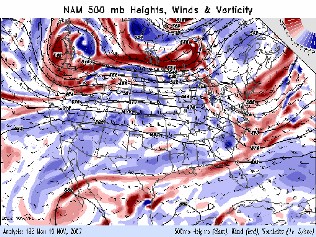
A computer model of wind patterns across the continental United States for 19 November, 2007. This model is used to forecast wind speeds and directions. Data on wind speed, direction, and related data are entered into a computer which then produces this simulation. This visual model is much easier for a person to understand than a large table of numbers.
Scientific Logic
During this activity students will formulate explanations by using logic and evidence. They will also use appropriate tools and technology to display data.
Have students come up with data online or do their own activity to generate data. Have the activity illustrate the area of biological study known as physiology. Have students work in pairs. Have the students take turns taking their pulses after sitting (pulse at resting), and then after jumping up and down after a time period, perhaps one to two minutes. Take pulses at varying times after the activity; immediately after, one minute after, two minutes after, etc. Data could be examined in a number of ways; how resting pulse compares to pulse right after the activity, at varying times after the activity, how long it might take to get back to a resting pulse, the differences in pulses between boys and girls, how pulse rate increases with how much time a person jumps (one minute vs. two minutes, etc.). Data could be presented in either graph or table form, or both. Have students come to a conclusion based on their results. The conclusion should be based on their evidence and scientific logic.
Science and Math
During this activity students need to understand the relationship between science and math.
Using a hypothetical rabbit population at Hardy-Weinberg equilibrium, have students de- termine both the allele frequencies and the genotype frequencies. This rabbit population has 9 albino rabbits and 91 brown rabbits (42 homozygous and 49 heterozygous rabbits).
Solution
Instructors: Sample answers to these questions will be provided upon request. Please send an email to teachers-requests to request sample answers.
Statistical Variability
Students will recognize the importance of statistical variability.
Biodiversity
Use activity 1 at the web site below to introduce the concept of biodiversity and how it is measured. In the activity, students calculate a diversity index for each of several different “habitats,” represented by plastic bottles that contain a variety of different dried beans, seeds, or other small items. Then, based on its diversity index, students decide what type of real-world habitat each bottle “habitat” best represents.
http://www.accessexcellence.org/AE/ATG/data/released/0534-KathyParis/index. php
In this activity students use math to calculate the diversity index of a selected habitat. The closer to 1 the diversity index is, the more diverse and healthy the habitat is.
Hypothesis vs. Theory
Ask students to develop a scientific hypothesis. They may use the activity below.
During this activity students should discuss the difference between their hypothesis and a scientific theory, describing why their hypothesis is not a theory. They should also appreciate the usefulness and limitations of theories as scientific representations of reality.
Formulating a Hypothesis
Scientific Theory
Scientific theories are hypotheses which have stood up to repeated attempts at falsification and are thus supported by a great deal of data and evidence. Some well known biological theories include the theory of evolution by natural selection, the cell theory (the idea that all organisms are made of cells), and the germ theory of disease (the idea that certain microbes cause certain diseases). The scientific community holds that a greater amount of evidence supports these ideas than contradicts them, and so they are referred to as theories.
In every day use, people often use the word theory to describe a guess or an opinion. For example, “I have a theory as to why the light bulb is not working.” When used in this common way, “theory” does not have to be based on facts, it does not have to be based on a true description of reality. This usage of the word theory often leads to a misconception that can be best summed up by the phrase ”It’s not a fact, it’s only a theory.” In such everyday usage, the word is most similar to the term hypothesis.
Scientific theories are the equivalent of what in everyday speech we would refer to as facts. In principle, scientific theories are always subject to corrections or inclusion in another, wider theory. As a general rule for use of the term, theories tend to deal with broader sets of phenomena than do hypotheses, which usually deal with much more specific sets of phenomena or specific applications of a theory.
When Data Does Not Fit
Students will understand that some observations may be wrong or fraudulent, and that some- times a theory can be wrong.
Refer students to the proposals of Jean-Baptiste Lamarck. He proposed that acquired char- acteristics could be inherited. Evidence did not support his mechanism for change, but Darwin shared his ideas of change in species.
A few websites are provided for additional information about Lamarck.
http://www.ucmp.berkeley.edu/history/lamarck.html
http://www.mnsu.edu/emuseum/information/biography/klmno/lemarck_jean.html
Maps
In this activity, students will learn the relationship between science and maps. Students should examine the maps below and determine what the data depicts.
Stabilizing Selection and Sickle-Cell Anemia
Stabilizing selection can lead to the preservation of harmful alleles. A famous example is sickle-cell anemia. The gene for Beta-hemoglobin - half of the oxygen-carrying protein in our blood - has two alleles, which we will call Hgb-A and Hgb-S. Individuals having two copies of the Hgb-S allele suffer from sickle-cell anemia, a potentially lethal disease in which sickled cells clog capillaries and cannot carry oxygen efficiently. In equatorial regions, individuals with two copies of Hgb-A become infected with Plasmodium parasites and often die from malaria. However, individuals with one copy of each allele (the heterozygous genotype) escape both causes of death; although they may experience slight sickling at high altitudes, they do not suffer from full-blown anemia, and malaria parasites cannot infect their red blood cells. Stabilizing selection has maintained the frequencies of both alleles, even though each is potentially lethal in the homozygous state.
Solution
Instructors: Sample answers to these questions will be provided upon request. Please send an email to teachers-requests to request sample answers.
Analysis of Natural Phenomena
Through a series of activities, students will understand that the analysis of locations, se- quences, or time intervals have played a significant role in the analysis of scientific data.
Virtual Age Dating
Assign the animated activity Virtual Age Dating at the web site below. Students will learn more about radioactive decay and radiometric dating of fossils and then simulate the collection and analysis of radiometric data. The activity includes questions for students to check their understanding as they proceed.
http://www.indiana.edu/~ensiweb/virt.age.html
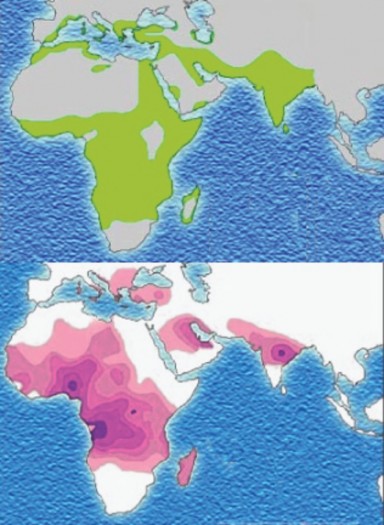
Figure 26.1: The distribution of malaria (top) and the distribution of the sickle-cell allele (bottom).? )
Geologic Timestring
Construct a geologic timestring (see URL below) that students can refer to as they read about evolution in this and subsequent lessons. The timestring is a physical representation of the geologic time scale. It is a simple tool that will help students comprehend the immensity of Earth’s history and how recently life evolved.
http://www.accessexcellence.org/AE/AEPC/WWC/1995/geo_time.php
Macroevolution: Patterns, Trends, and Rates of Change
After you discuss gradualism and punctuated equilibrium, ask students to complete the activity Macroevolution: Patterns, Trends, and Rates of Change (see URL below). In the activity, students will examine and graph patterns of fossil sequences and will decide whether the patterns support a gradualism or punctuated equilibrium model of evolution.
http://www.indiana.edu/~ensiweb/lessons/macroev.html
An Accumulation of Evidence
Students will understand the cumulative nature of scientific evidence.
Evidence of Evolution
Refer students to Lesson 12.2: Evidence for Evolution.
Have them create an outline of the lesson content or write an essay discussing the different types of evidence of evolution. All students should include a conclusion tying the evidence together, and discussion why this accumulation of evidence is a scientific theory.
Additional Scientific Disciplines
In this discussion and research project, students will analyze situations and solve problems that require combining and applying concepts from biology, ecology, chemistry and atmo- spheric sciences. Students will further investigate this extremely important issue.
Global Warming
Make sure students understand the greenhouse effect by working through the diagram in this Figure with the class.
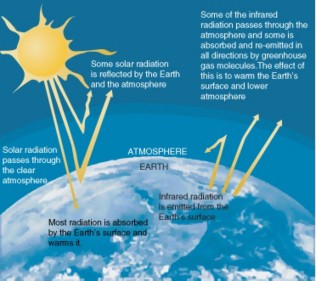
Discuss how the greenhouse effect is related to global warming. Specifically, discuss the following points:
What is the greenhouse effect?
The greenhouse effect is a natural consequence of Earth’s atmosphere. Why?
Without the greenhouse effect, Earth’s average temperature would be much lower. Why?
Changes in Earth’s atmosphere (especially increased CO2) have increased the green- house effect and Earth’s average temperature. How?
Have students continue this analysis with further research on this or a related topic. Students should research the literature, analyzing data that they find and communicate their findings to the class. Aspects of the greenhouse effect that may be further investigated include:
potential issues for plants and animals associated with this effect
any relationship between the greenhouse effect and global warming
potential effects of global warming.
- Log in or register to post comments
- Email this page
